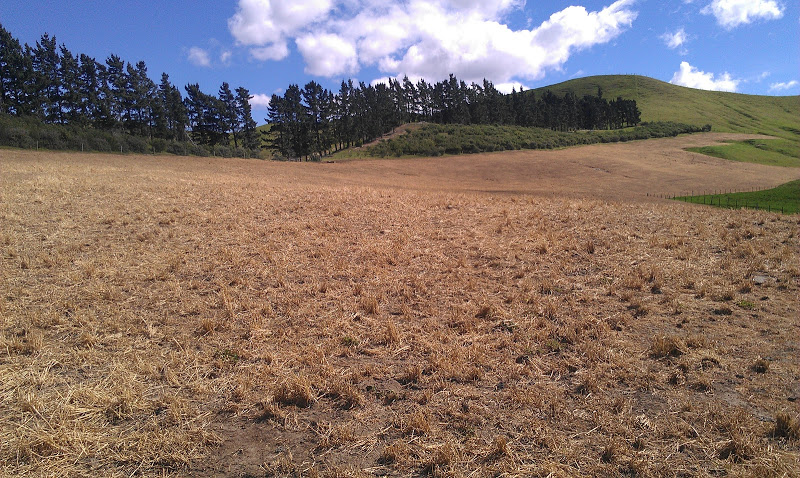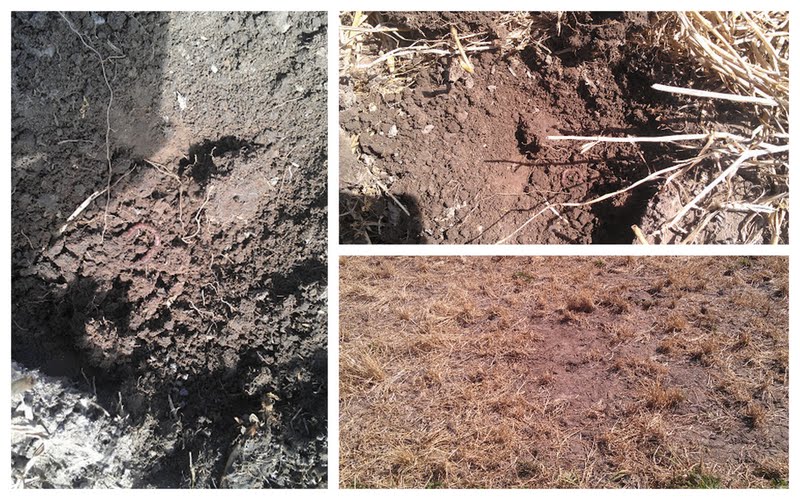The journey to a new paddock of Bonavaree mix (Prairie Grass, Lucerne, Plantain) is well under way now. We visited the North Face paddock again last week, and it was looking vastly different to last time, see photos below.
From this
to this
Plans for this paddock from our last visit went according to schedule and were as follows: Remove mob of hoggets, then graze hard (5 cm) with cattle, allow a short regrowth period (2 days) to freshen up the vegetation, and then spray with 4 L/ha Glyphosate360 and 25 g/ha Sharpen.
You can see in the photo above that the spray has done an excellent job of killing the resident vegetation. Doug and Fraser are pleased with the result from the new herbicide mix
so far. The existing sprayed out vegetation is approximately 5-10 cm in height. Retaining some plant litter on the surface is so important in the fallow period when using minimum tillage in order to retain soil moisture within the soil profile, and reduce moisture loss from a bare soil surface.
Soil conditions are perfect for drilling, you can see in the photo below that, with a minimal dig around with the spike from my pasture height measuring stick, the soil tilth is crumbly and friable. Soil moisture also looks to be ideal, although dry looking on top, the soil moisture was visible from approximately 0.5 cm down. Earthworms also evident (photo below).
The Omaka Barley has been a very successful break crop, and works so incredibly well within the Bonavaree farm system when renovating pastures. Omaka works well here because it:
- fits animal feed requirements,
- prevents weed ingression,
- retains soil structure,
- builds up soil organic matter and base soil fertility
- Is a hardy variety that performs well in the Marlborough dryland environment.
Fraser has plans to apply 80 kg/ha Di-Ammonium Phosphate (DAP) down the spout at drilling. He has based this on the recent soil tests (table below) which were taken on 12 September.
| Soil Test | North Face test Result | Unit | Range |
| pH | 6.1 | pH | 6.0-6.5 |
| Olsen Phosphorous | 23 | mg/L | 15-25 |
| Potassium | 1.29 | me/100 | 0.30-0.50 |
| Calcium | 8.7 | me/100 | 4.0-10.0 |
| Magnesium | 2.28 | me/100 | 0.50-1.0 |
| Sodium | 0.3 | me/100 | 0.10-0.50 |
| CEC | 16 | me/100 | 12-25 |
| Volume Weight | 0.79 | g/mL | 0.60 – 1.0 |
| Sulphate Sulphur | 10 | mg/kg | 10 – 15 |
| Extractable Organic | 9 | mg/kg | 15 – 20 |
Please note these soil sample cores are taken to a depth of 15 cm, owing to the deeper soil testing requirement of the lucerne component in the mix.
Drilling is planned to occur this week depending on weather conditions.



Hi all…
I am the Technical Manager for BASF, who developed Sharpen herbicide. I see that the results you have had are good. Just a couple of points to consider.
1. Sharpen really needs an esterified canola oil (ours is Hasten) to fire up on some weeds so if an adjuvant was use all is ok. If not, and you are looking at Sharpen use, bear in mind the best results will be from Hasten, then the silicon based products and it’s a long way back to the non-ionics or petroleum oils.
2. The Omaka barley could have been planted the day after spraying! The plantbacks are determined by canopy cover and if there is good spray interception >80% then very short plantbacks are possible. A little less canopy cover affects the legumes and brassicas but not the grasses.
Also we are looking at 2nd yr lucerne use with Sharpen. No trials done in NZ but USA are developing it. Email me for info. And one more – we also have had good results with Pulsar over established lucerne (Bentazone + MCPB) and are working towards a registration. The only issue is convincing the market MCPB is “about” as safe as 2,4-DB. Any comment would be welcome.
Cheers
Grant Hagerty
Technical Manager
BASF New Zealand Limited
I note your comments on using Pulsar over established Lucerne.
what is the best herbicide for thistle control in seedling lucerne? Have used straight 24DB in the past (South Canterbury), was very hit and miss.
In an established lucerne stand in most cases we avoid using expensive herbicides such as Velpar DF ($150 -$200/ha). We do use such chemicals were the lucerne establishment is under threat and Velpar is a very effective option for various weeds but can cause damage on young stands. I would recommend paddocks be inspected first by experienced agronomists before committing to this option. Velpar does get Nodding thistles.
People also report success with a well maintained and calibrated weed wiper or wick boom. Directly after grazing Metsulfuron (Associate/Zeal etc) @ 2-3 g/litre water with a SLOW double pass (East-West/ North – South) ensuring that the boom is totally saturated with the mix before starting. This option is widely used and is very cost effective.
For a seedling crop 2,4DB is the recommendation for Californian thistles. In a cut and carry system the cutting usually takes care of them. For other thistles other options may be requried.
Hi Grant,
We have used Sharpen with an adjuvant this spring with good results so far.
Looking to use Sharpen in the autumn on runout lucerne that has a dandelion problem.
Would be interested to know what results you have from trials on 2 yr lucerne.